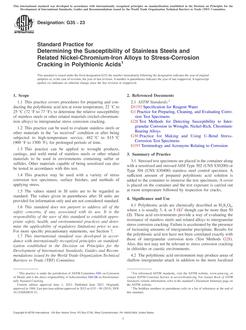
ASTM D7783-12
1.1 This Practice establishes a uniform standard for computing the within-laboratory quantitation estimate associated with Z % relative standard deviation (referred to herein as WQEZ %), and provides guidance concerning the appropriate use and application.
1.2 WQEZ % is computed to be the lowest concentration for which a single measurement from the laboratory will have an estimated Z % relative standard deviation (Z % RSD, based on within-laboratory standard deviation), where Z is typically an integer multiple of 10, such as 10, 20, or 30. Z can be less than 10 but not more than 30. The WQE10 % is consistent with the quantitation approaches of Currie (1) and Oppenheimer, et al (2).
1.3 The fundamental assumption of the WQE is that the media tested, the concentrations tested, and the protocol followed in the developing the study data provide a representative and fair evaluation of the scope and applicability of the test method, as written. Properly applied, the WQE procedure ensures that the WQE value has the following properties:
1.3.1 Routinely Achievable WQE Value – The laboratory should be able to attain the WQE in routine analyses, using the laboratory‘s standard measurement system(s), at reasonable cost. This property is needed for a quantitation limit to be feasible in practical situations. Representative data must be used in the calculation of the WQE.
1.3.2 Accounting for Routine Sources of Error – The WQE should realistically include sources of bias and variation that are common to the measurement process and the measured materials. These sources include, but are not limited to intrinsic instrument noise, some typical amount of carryover error, bottling, preservation, sample handling and storage, analysts, sample preparation, instruments, and matrix.
1.3.3 Avoidable Sources of Error Excluded – The WQE should realistically exclude avoidable sources of bias and variation (that is, those sources that can reasonably be avoided in routine sample measurements). Avoidable sources would include, but are not limited to, modifications to the sample, modifications to the measurement procedure, modifications to the measurement equipment of the validated method, and gross and easily discernible transcription errors (provided there was a way to detect and either correct or eliminate these errors in routine processing of samples).
1.4 The WQE applies to measurement methods for which instrument calibration error is minor relative to other sources, because this Practice does not model or account for instrument calibration error, as is true of quantiation estimates in general. Therefore, the WQE procedure is appropriate when the dominant source of variation is not instrument calibration, but is perhaps one or more of the following:
1.4.1 Sample Preparation, and especially when calibration standards do not go through sample preparation.
1.4.2 Differences in Analysts, and especially when analysts have little opportunity to affect instrument calibration results (as is the case with automated calibration).
1.4.3 Differences in Instruments (measurement equipment), such as differences in manufacturer, model, hardware, electronics, sampling rate, chemical-processing rate, integration time, software algorithms, internal signal processing and thresholds, effective sample volume, and contamination level.
1.5 Data Quality Objectives – For a given method, one typically would compute the lowest % RSD possible for any given data set. Thus, if possible, WQE10 % would be computed. If the data indicated that the method was too noisy, one might have to compute instead WQE20 %, or possibly WQE30 %. In any case, a WQE with a higher % RSD level (such as WQE50 %) would not be considered, though a WQE with RSD <10 % (such as WQE1 %) would be acceptable. The appropriate level of % RSD is based on the data-quality objective(s) for a particular use or uses. This Standard allows for calculation of WQEs with user selected %RSDs less than 30%.
1.6 The values stated in SI units are to be regarded as the standard. The values given in parentheses are for information only.
1.7 The values stated in inch-pound units are to be regarded as standard. The values given in parentheses are mathematical conversions to SI units that are provided for information only and are not considered standard.
Product Details
- Published:
- 04/01/2012
- Number of Pages:
- 13
- File Size:
- 1 file , 300 KB

